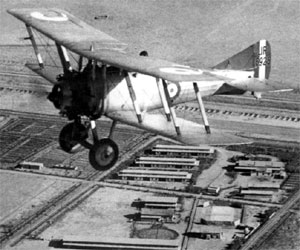
A flat-twin engine is a two-cylinder internal combustion engine with the cylinders on opposite sides of the crankshaft. The most common type of flat-twin engine is the boxer-twin engine, where both pistons move inwards and outwards at the same time.

The Armstrong Whitworth Siskin was a biplane single-seat fighter aircraft developed and produced by the British aircraft manufacturer Armstrong Whitworth Aircraft. It was also the first all-metal fighter to be operated by the Royal Air Force (RAF), as well as being one of the first new fighters to enter service following the end of the First World War.

The Rolls-Royce Eagle was the first aircraft engine to be developed by Rolls-Royce Limited. Introduced in 1915 to meet British military requirements during World War I, it was used to power the Handley Page Type O bombers and a number of other military aircraft.

Sheffield-Simplex was a British car and motorcycle manufacturer operating from 1907 to 1920 based in Sheffield, Yorkshire, and Kingston upon Thames, Surrey.

Douglas was a British motorcycle manufacturer from 1907–1957 based in Kingswood, Bristol, owned by the Douglas family, and especially known for its horizontally opposed twin cylinder engined bikes and as manufacturers of speedway machines. The company also built a range of cars between 1913 and 1922.

Blériot Aéronautique was a French aircraft manufacturer founded by Louis Blériot. It also made a few motorcycles between 1921 and 1922 and cyclecars during the 1920s.
The Green Engine Co was a British engine company founded by Gustavus Green in Bexhill to sell engines of his design. He flourished especially as a designer of aeroplane engines during the first two decades of the 20th century. The engines were actually manufactured by the Aster Engineering Company.

The ABC Wasp was an experimental 170 hp (127 kW) seven-cylinder radial engine designed by the noted British engineer Granville Bradshaw, and primarily built by ABC Motors Limited. An order for twelve experimental ABC Wasp engines was placed with Guy Motors on 19 April 1918. Eight ABC Wasp engines were made by Crossley Motors Ltd of Manchester, England.
Blackburne was a trade name of Burney and Blackburne Limited a British manufacturer of motorcycles from 1913 to 1922 at Tongham near Farnham, Surrey. They were also a major supplier of engines to other motor cycle and light car makers and continued to make these until 1937. Burney and Blackburne also made small aircraft engines.

The Nieuport Nighthawk was a British fighter aircraft developed by the Nieuport & General Aircraft company for the Royal Air Force towards the end of the First World War. Although ordered into production before the aircraft first flew, it did not enter large scale service with the RAF owing to unreliable engines. Re-engined aircraft did see service in Greece, serving from 1923 to 1938.

The ABC Dragonfly was a British radial engine developed towards the end of the First World War. It was expected to deliver excellent performance for the time and was ordered in very large numbers. It proved, however, to be extremely unreliable and was abandoned when its faults were unable to be corrected.

ABC motorcycles was a British motorcycle manufacturer established in 1914 by Ronald Charteris in London. Several British motorcycle firms started up with the name "ABC", including Sopwith. The All British Engine Company Ltd. of London was founded in 1912 and later changed to ABC Motors Ltd. With chief engineer Granville Bradshaw, Charteris built a range of engines throughout the First World War. From 1913 ABC produced motorcycle engines.
The Advance Motor Manufacturing Company was a British motorcycle and engine manufacturer established in 1905. As well as supplying aircraft engines to the pioneering monoplane developers, Advance engines were also used by Captain Robert Scott to power Antarctic snow sleds. After the end of the Second World War the company was sold to Sheepbridge Engineering and became a motor supplies organisation.

The ABC Scorpion is a 30 hp (22 kW) two-cylinder aero engine designed by British engineer Granville Bradshaw for use in light aircraft. The engine was built by ABC Motors Limited and first ran in 1921.

The ABC 8 hp is an 8 hp (6 kW) two-cylinder aero engine designed by the noted British engineer Granville Bradshaw for use in ultralight aircraft. The engine was derived from a specially tuned motorcycle unit and was built by ABC Motors, first running in 1923.
Granville Eastwood Bradshaw OBE, AFRAeS (1887–1969) was an English engineer and inventor who designed motorcycle, auto, and aero-engines.
The ABC Gnat was a 45 hp (34 kW) two-cylinder aero engine designed by British engineer Granville Bradshaw for use in light aircraft. The Gnat was built by ABC Motors, first running in 1916, production ceased in December 1918. 17 engines were built from an original order of 18.
The ABC Mosquito was a 120 hp (90 kW) six-cylinder radial aero engine designed by the noted British engineer Granville Bradshaw for use in light aircraft. The single Mosquito engine was built by ABC Motors, first running in 1916. It is thought that the design resulted from a bet between Harry Hawker and Bradshaw, Hawker proposing that Bradshaw could not build and fly a six-cylinder radial engine. The Mosquito used copper-plated steel Gnat cylinders. The engine was not a success.
The ABC Hornet was an 80 hp (90 kW) four-cylinder aero engine designed in the late 1920s by the noted British engineer Granville Bradshaw for use in light aircraft. The Hornet was effectively a double Scorpion and was built by ABC Motors, first running in 1929.

The Salmson water-cooled aero-engines, produced in France by Société des Moteurs Salmson from 1908 until 1920, were a series of pioneering aero-engines: unusually combining water-cooling with the radial arrangement of their cylinders.














